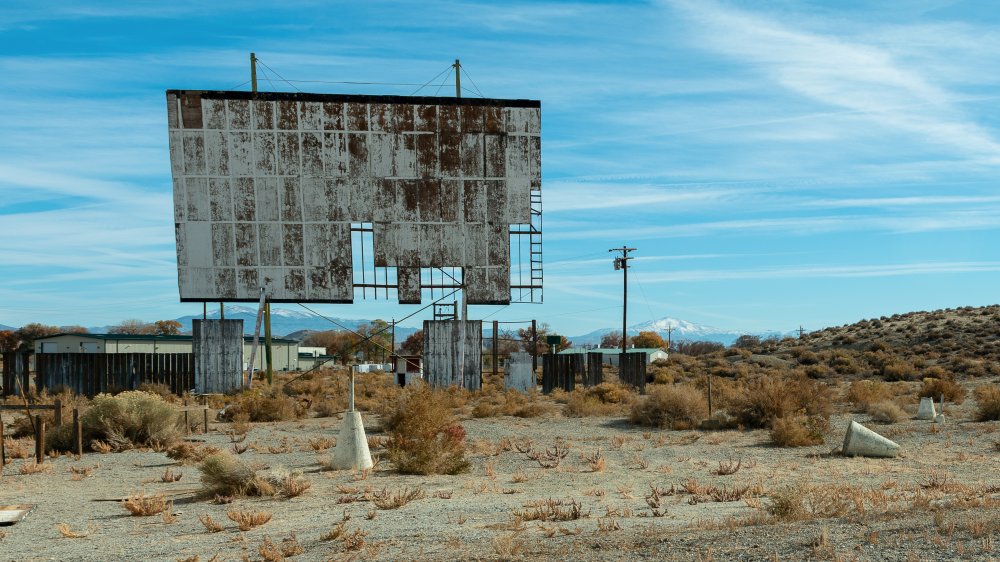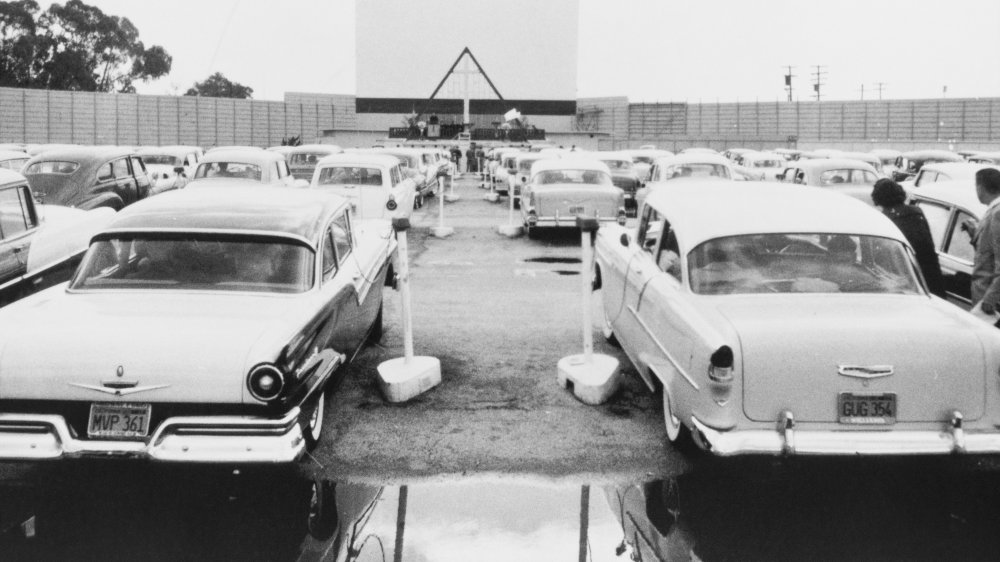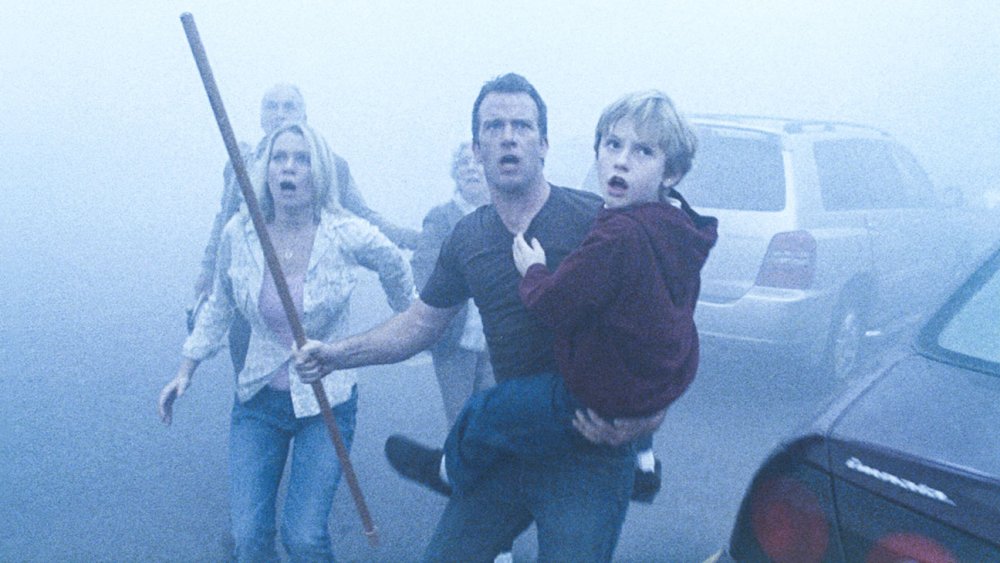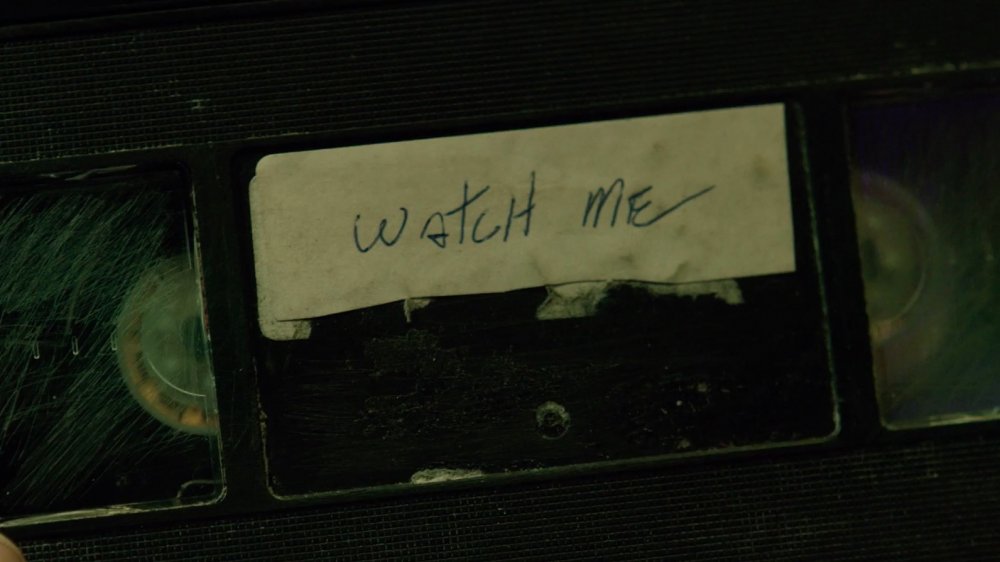The Real Reason Most Drive-In Movie Theaters Closed
Drive-in theaters are an iconic symbol of Americana. Their presence in film and TV usually represent a rose-colored rearview of '50s and '60s pop culture: cars with flashy fins, soda fountains, all that jazz. It hearkens back to a more one-to-one moviegoing experience — food was brought to you, the car would provide more privacy than today's stadium seating does, and there was a fun group dynamic to camping out under the stars and in front of the silver screen. It was a lot cheaper, too, than what we must pay today to go see our favorite new Marvel film.
You hardly see drive-ins today, beyond perhaps the occasional grass-grown ruin on the side of a county highway in some rural exurbs. The ones that still operate largely do so on a novelty basis and definitely aren't getting rich on it. One could almost argue it's more of an enthusiast's game, now — a hobby for those who can afford upkeep on something that will eternally struggle to turn any profit at all.
The drive-in's halcyon days are well behind us now, never to return. Time is the enemy of all fad institutions, but what happened to drive-ins was a confluence of effects both obvious and surprising. Here's why drive-ins have largely closed across the U.S. and why it's likely going to stay that way.
Exurb encroachment was the beginning of the end for drive-in theaters
Urban and exurban sprawl is a substantial undercurrent leading to the demise of drive-ins. At first blush that feels obvious, because we all know there's less physical space available than in the '50s and '60s when the suburban boom first began. Still, it's more complicated than that. It takes a lot of land to run a drive-in theater, and their business model often meant charging less per customer — sometimes they'd offer a flat fee or discounted rate for just the car's entry, no matter the occupancy. Volume of cars takes precedence to make up for the cheaper ticket offering. On top of that, a majority of America's landscape is bound to go through at least a couple months a year of prohibitively cold temperatures — if not snow — meaning that many drive-ins could only operate seasonally.
All that would have made it difficult to stay in the black with large tracts of land by 1950s standards, but by the time the '70s set in, urban sprawl ate up more and more formerly-rural land. With that, property taxes rose due to the value of the land itself going up from being closer to a city proper. Owing thousands of dollars in taxes at the end of a year in which a profit margin is thin to begin with will destroy any business. It would have been much more valuable to sell land off to development, and it was, especially in the mall-crazy culture of the '80s.
Mid-century social tastes couldn't outlast a changing economy
It's important to remember what the post-war world was like and what was mattered to a society still emerging from major years-long rationing. The car was a huge status symbol at that time, as people had had to go the entirety of the war, even before Americans formally joined, without new tires and with limited amounts of gas. Metal was heavily rationed too, and from 1942-1945, just 139 new cars were made due to auto manufacturers dedicating resources to aircraft parts, fuselages, and engines.
All of that came roaring back with a vengeance as men returned home from overseas, and the car became the ultimate sign of leaving the war behind and doing what you wanted, when you wanted, without a care in the world. That began to ebb come the '70s, and the energy crisis and oil embargo of 1973 finished off that stylized car culture for a long while. Cars became utilitarian tools more and more, and the expense of owning one over time meant less frivolous use of them. With brick-and-mortar theaters proving more convenient and cost-efficient for both customers and owners, the writing was on the wall for the drive-in.
Drive-ins couldn't keep up with the switch to digital projection
Studios and drive-ins have had a less-than-friendly business relationship. Since it's far cheaper to attend a drive-in, which only charges by the car and not by the head, revenue from them is drastically less than a traditional theater — a business which, over the years, has only continued to homogenize through mergers and acquisitions because their revenue has steadily declined too. There are very few local independent theaters anymore, so the corporate grip is strong all the way down the chain.
This has caused the studio industry to stop granting first-run licenses to drive-ins. That means these theaters are not permitted to run any film immediately upon release, and will only be granted license to run prints that have been used already in other theaters — and since hardly any of the few surviving drive-ins can afford to go digital (more on that in a moment), that means literal prints on celluloid. Film stock doesn't hold up well after being played dozens of times in one or even multiple first-run theaters, so the visual quality will suffer greatly with color fade and scratches.
No drive-in can possibly compete with today's multiplex sound system, either. Even at a rock-bottom price, without the addition of a unique gimmick experience that isn't so much about watching the movie — a good example is a drive-in theater that ran The Mist with timed fog machines as a "special effect" — the cost benefit isn't all that attractive to today's moviegoer. On top of that, it's getting close to impossible to get ahold of physical film prints at all.
Time and tech march on, leaving drive-ins in the dust
The progress of technology since the '70s has delivered a one-two punch to the survival of drive-ins. The first was home video, and the second was the all-digital distribution revolution. As the popular interest in drive-ins waned and the theaters were demoted to second-run status, VCRs began to arrive in homes everywhere. Outside of the occasional flare of nostalgia, why would most people take the time, expense, and effort to see a movie that's been out for months already if they could just wait a little longer and stay home? We see that rationale bandied about today with the rise of streaming versus brick-and-mortar theaters, after all. Once upon a time, the theater industry and studios pushed back very hard on the ascension of home video, fearing that ticket revenues would drop. While that ended up not being true by and large, it absolutely was true for theaters that did not have the benefit of being able to show new movies on release.
The final nail in the coffin, even for those drive-ins that have survived this long, is the industry-wide shift over to digital-only distribution. There are all the reasons in the world to do it: it's cheaper to distribute, digital is typically higher-fidelity in both sound and visuals, and it doesn't suffer the deterioration that film does. The trouble is, however, the expense. Traditional theaters argued for years with studios about making the transfer to digital because overhauling and maintaining all those systems was never going to be cheap. If the multi-billion dollar chain theater industry had to fight over who would pay for it, it's even more out-of-reach for mom and pop drive-in operations. A few have scratched together the money to buy one, but the prohibitive cost shuts down more than it keeps open.
If you're lucky enough to have a drive-in theater still in operation near you, take an evening to revel in a rare moviegoing experience from a bygone age.




